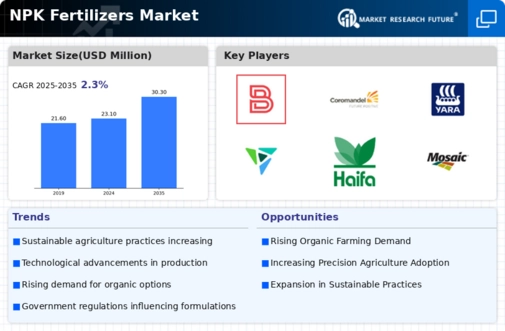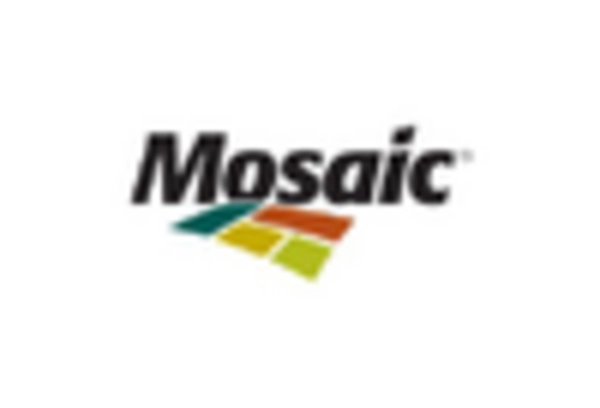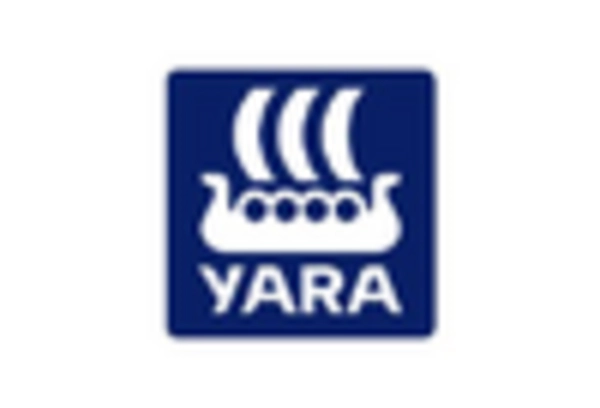Market Share
Introduction: Navigating the Competitive Landscape of NPK Fertilizers
As the NPK fertilizers market evolves, competitive momentum is increasingly shaped by technological advancements, regulatory changes, and shifting consumer expectations for sustainability. Key players, including traditional manufacturers, innovative agritech firms, and sustainability-focused startups, are vying for leadership through differentiated offerings. Established OEMs leverage AI-based analytics and IoT solutions to optimize product formulations and enhance yield efficiency, while emerging players disrupt the status quo with biomimetic fertilizers and precision agriculture technologies. Regional growth opportunities are particularly pronounced in Asia-Pacific and Latin America, where agricultural modernization and increased food production demands drive strategic deployments. As we look towards 2024-2025, the integration of green infrastructure and automation will be pivotal in defining market share dynamics, compelling stakeholders to adapt swiftly to maintain competitive advantage.
Competitive Positioning
Full-Suite Integrators
These vendors offer comprehensive solutions across the NPK fertilizer spectrum, integrating production, distribution, and customer support.
| Vendor | Competitive Edge | Solution Focus | Regional Focus |
|---|---|---|---|
| BASF SE | Strong R&D capabilities | Chemical fertilizers | Global |
| Yara International | Sustainability-focused solutions | NPK fertilizers | Europe, Asia, Americas |
| CF Industries Holdings | Leading nitrogen production | Nitrogen fertilizers | North America |
| The Mosaic Company | Integrated phosphate and potash producer | Phosphate and potash fertilizers | North America, South America |
Specialized Technology Vendors
These companies focus on innovative technologies and specialized products within the NPK fertilizer market.
| Vendor | Competitive Edge | Solution Focus | Regional Focus |
|---|---|---|---|
| FEECO International Inc. | Custom equipment solutions | Fertilizer production equipment | Global |
| Haifa Group | Controlled-release fertilizers | Specialty fertilizers | Global |
Infrastructure & Equipment Providers
These vendors supply essential infrastructure and equipment necessary for the production and distribution of NPK fertilizers.
| Vendor | Competitive Edge | Solution Focus | Regional Focus |
|---|---|---|---|
| Potash Corporation of Saskatchewan | Large-scale potash production | Potash fertilizers | North America, Asia |
| K + S Aktiengesellschaft | Diverse mineral resources | Potash and salt products | Europe, North America |
| Borealis AG | Innovative polymer solutions | Fertilizer production | Europe, Middle East |
| Coromandel International | Strong local market presence | NPK fertilizers | India |
| Hindalco | Integrated aluminum and fertilizer production | NPK fertilizers | India |
Emerging Players & Regional Champions
- AgroTech Solutions (India): Specializes in customized NPK formulations tailored for specific crops, recently secured a contract with a major agricultural cooperative in Maharashtra, challenging established vendors by offering localized solutions that enhance crop yield and soil health.
- GreenFert (Brazil): Focuses on organic NPK fertilizers derived from sustainable sources, recently implemented a pilot project with a large-scale sugarcane producer, complementing traditional chemical fertilizers by providing eco-friendly alternatives that appeal to environmentally conscious farmers.
- NPK Innovations (USA): Develops slow-release NPK fertilizers using advanced polymer technology, recently partnered with a university for research on nutrient efficiency, challenging established vendors by introducing innovative products that reduce nutrient leaching and improve application efficiency.
- Fertile Future (Africa): Offers affordable NPK blends aimed at smallholder farmers, recently launched a distribution network in Kenya, complementing established vendors by filling the gap in the market for cost-effective solutions that enhance food security.
Regional Trends: In 2024, there is a notable trend towards the adoption of sustainable and organic NPK fertilizers, particularly in regions like South America and Africa, where environmental concerns are driving demand. Additionally, technology specialization is emerging, with companies focusing on slow-release formulations and precision agriculture techniques to optimize nutrient delivery and minimize environmental impact.
Collaborations & M&A Movements
- Nutrien and Yara International entered into a partnership to develop sustainable NPK fertilizer solutions aimed at reducing carbon emissions in agricultural practices, enhancing their competitive positioning in the eco-friendly segment of the market.
- CF Industries announced the acquisition of OCI's North American nitrogen business to expand its NPK fertilizer production capacity, significantly increasing its market share and operational efficiency in the North American region.
- BASF and K+S Potash Canada collaborated to innovate new NPK fertilizer formulations that improve nutrient efficiency, positioning both companies as leaders in sustainable agricultural solutions amidst increasing regulatory pressures for environmental compliance.
Competitive Summary Table
| Capability | Leading Players | Remarks |
|---|---|---|
| Nutrient Composition Optimization | Nutrien, Yara International | Nutrien utilizes advanced soil testing technologies to tailor nutrient compositions, enhancing crop yield. Yara's proprietary YaraTera products are designed for specific crop needs, demonstrating strong adoption in precision agriculture. |
| Sustainability Practices | CF Industries, OCP Group | CF Industries has implemented carbon capture technologies in its production processes, significantly reducing emissions. OCP Group focuses on sustainable phosphate mining and has received recognition for its environmental stewardship initiatives. |
| Product Innovation | ICL Group, K+S AG | ICL Group has introduced slow-release NPK fertilizers that improve nutrient availability over time, appealing to environmentally conscious farmers. K+S AG is known for its innovative formulations that enhance soil health and crop resilience. |
| Distribution Network Efficiency | Mosaic Company, Tessenderlo Group | Mosaic Company has optimized its supply chain logistics, ensuring timely delivery of fertilizers to farmers. Tessenderlo Group leverages a robust distribution network across Europe, enhancing market reach and customer service. |
| Digital Agriculture Integration | BASF, Syngenta | BASF has integrated digital tools into its fertilizer offerings, providing farmers with data-driven insights for optimal application. Syngenta's digital platform offers tailored recommendations based on real-time data, improving adoption rates among tech-savvy farmers. |
Conclusion: Navigating NPK Fertilizers Competitive Landscape
The NPK fertilizers market in 2024 is characterized by intense competitive dynamics and significant fragmentation, with both legacy and emerging players vying for market share. Regional trends indicate a growing emphasis on sustainability and eco-friendly practices, prompting vendors to innovate their product offerings. Legacy players are leveraging established distribution networks and brand loyalty, while emerging companies are focusing on advanced capabilities such as AI-driven precision agriculture and automation to enhance operational efficiency. As the market evolves, the ability to adapt to changing consumer preferences and regulatory landscapes will be crucial. Vendors that prioritize sustainability, flexibility in product formulations, and technological integration will likely emerge as leaders in this competitive arena, positioning themselves to meet the demands of a rapidly changing agricultural landscape.

















Leave a Comment